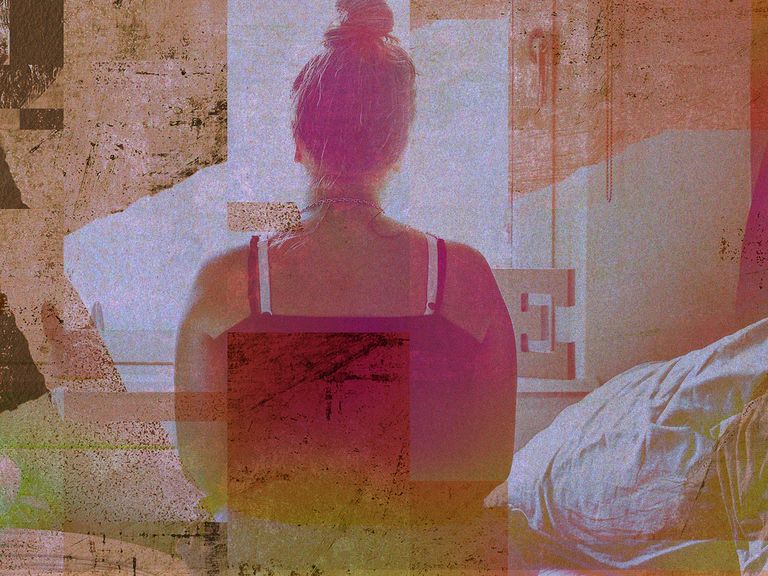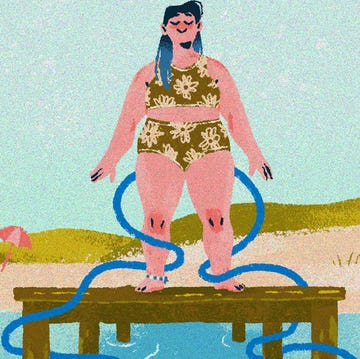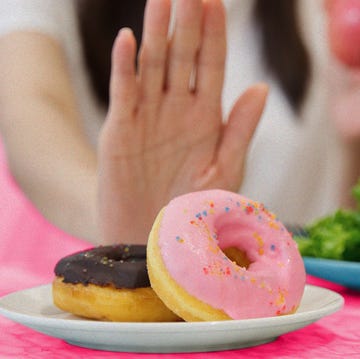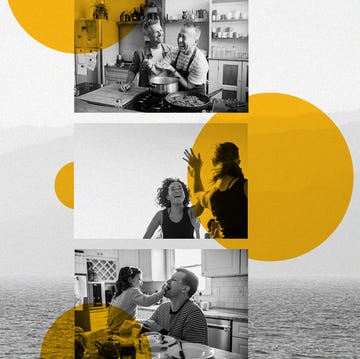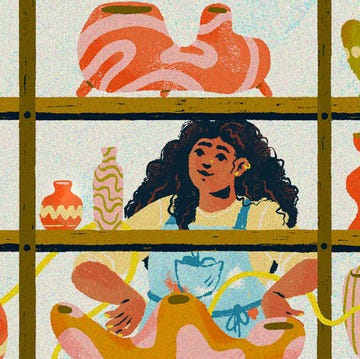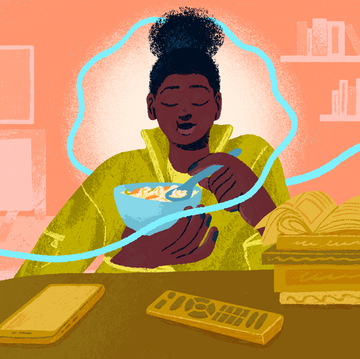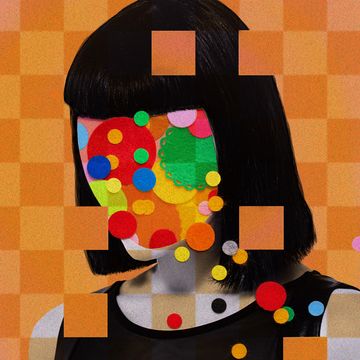I sat on my porch chatting and sipping wine with my neighbor, who was complaining about her moody boss. “I think she’s bipolar,” she said in a joking manner. I laughed along, but inside, my body tensed. This friend had no idea that, for decades, my mom suffered from bipolar disorder.
When she changed the subject, I felt relieved. While mental health is in the forefront of the news, I rarely share my mom’s story. Unless they’ve been directly affected, most people don’t understand. Plus, I have always been fearful of telling others about her illness. What will they think of me? Will they wonder if I inherited the genetic link to her madness?
“I can’t talk,” my mom whispered on the phone one day in 1992. “There’s a green Martian standing here.” After she hung up, I listened to the dial tone. Shocked. At 19, I was a college sophomore 1,000 miles away in Florida. I felt completely alone and terrified.
This phone call set off a spiral of events. She disappeared in New York City for three days, disposing of her car keys in a dumpster before shopping at an expensive shoe store, where she handpicked selections for the Father, Son, and Holy Ghost. One pair for each.
Eventually, my mother wound up in a psychiatric ward, where doctors diagnosed her with bipolar I disorder (formerly called manic depression). She was 46 years old, divorced, and unemployed.
According to the National Institute of Mental Health, approximately 4.4 percent of Americans experience bipolar disorder in their lives, which equally affects men and women. They can exhibit dramatic fluctuations in mood, energy, and the ability to think clearly. These flare-ups are much more severe and long lasting than the mood changes of daily life. Symptoms can range from debilitating depression, extreme euphoria, and hallucinations.
Prior to her diagnosis, my only reference to my mom’s illness was the Jimi Hendrix song “Manic Depression.” I sang along to the lyrics without truly understanding — or caring about — their meaning.
My mom’s age of diagnosis was atypical. Most people develop symptoms much earlier than she did at age 46, usually during adolescence or early adulthood. In her case, I think she spent a good portion of my childhood hypomanic, alternating with periods of depression. With hypomania, a person can still function seemingly well, at least in the eyes of outsiders. Charged with energy, they have high activity levels, completing tasks with a renewed sense of confidence.
My mom was an artist, always working late to finish her graphic design projects, a Kool Light burning in the ashtray, Mozart on the record player. At first, her eclectic behavior fit the artistic mold. In retrospect, these erratic patterns made more sense. Moving every two years. Her frequent job changes, including Amway consultant, Yellow Pages sales rep, diner waitress, and dating service business owner. Her bouts of depression, where she stayed in bed for days, abandoning me to instead keep company with sitcom characters like Fonzie, Laverne, Shirley, Mork, and Mindy.
The summer before my senior year of high school, my mom had her first psychotic episode. Thinking that she had magical powers, she told my friend’s mother that she could heal her. “Say goodbye to your glasses,” my mom declared to this woman in 1989. “Your eyesight is cured!”
After a one-week stay in the psychiatric ward of a New Jersey hospital, the doctors released her, misdiagnosing her condition as a nervous breakdown. The experience cost my mother our house, her savings, and job. As a result, I moved in with a neighbor for my senior year before going to Florida for college the following summer. I never lived with my mom again.
My mother began taking medication after her official diagnosis in 1992. Although the meds helped at times, it was difficult to find the right dosage and drugs that worked for her. Like many people with bipolar disorder, she often discontinued taking her pills altogether. This ignited more periods of mania and depression. Multiple hospitalizations for highs and lows.
Whenever she stopped taking her medicine, it infuriated me. How could she be so careless? Why would she do something that would likely land her back in the hospital? How could she do this to me? When I first learned of my mom’s condition, I expected her to bounce back, as she had when faced with challenges before.
My mother was forced to reestablish herself many times over the years: when she divorced my dad, after an eviction and a house foreclosure, and investing — and losing — her savings in a multilevel marketing venture. I wanted her to be her “old self” again, my “cool” mom who meditated, did yoga, and ate seaweed long before it was hip. I wanted the mother back who let my teenage friends smoke cigarettes on the striped velour couch in our living room.
Instead of accepting her new reality, I wanted her to act normal, to shake off the stigma and return to her old life. It wasn’t that easy. Although she had the support of friends and family, my mom struggled to regain her former independence, both personally and professionally. In the end, it was her physical, not mental, health that finally caught up with her. She died at age 58 of colon cancer.
At a salon appointment last year, I made small talk with the stylist while she expertly applied highlights to my hair. I’d been going to this same hairdresser for years and enjoyed our easy conversations. She told me about her boyfriend, golf hobby, and frequent trips to Florida. If I needed a restaurant recommendation, she always knew just the place. “What are your plans for tonight?” I asked, smiling at her reflection in the mirror and ready to be dazzled by her exciting social life.
“I’m supposed to go to a party at a friend’s house, but I wish I could get out of it,” she answered, applying a new piece of foil to my head. She looked around, as if the host of the party was near. “Her husband is bipolar. So is her daughter.” My hair stylist’s eyes met mine. I looked away. Like with my neighbor, I froze. I couldn’t say anything. Soon, the subject changed, and I exhaled, happy to be swept away to a new topic.
In an op-ed published last August in the Los Angeles Times, California’s acting surgeon general Devika Bhushan revealed her own bipolar disorder diagnosis, including the shame that initially kept her from telling others, even her medical colleagues.
Like my mom, Bhushan had ups and downs. Unlike my mom, she conquered her illness and with the help of therapy, medication, and the support of loved ones “got her full self back.” At the end of her essay, she asked readers to consider sharing their own stories because “stigma festers in the dark and scatters in the light.”
I am older now than my mom was at the age of her diagnosis, with two teenage children and a job as an elementary school teacher. I realize that I had no idea what it felt like to be in my mother’s situation. How scared she must have been. How alone. She suffered from bipolar disorder, but that did not define her as a person. At the same time, it was part of her life to be acknowledged, not hidden away, and certainly not something to be ashamed about.
Recently, I was taking a walk with a former work colleague. We caught up on the usual things: our kids, jobs, family. Somehow, the subject turned to our childhoods, senior year of high school in particular. “I lived with my neighbor,” I told her, listening to the crunch of leaves under my sneakers. She asked why. I hesitated and felt the usual pit forming in my stomach. “It’s a long story” was usually my go-to answer in these situations. Then, I would deftly steer the conversation in a new direction. Surprisingly, this always worked.
At that moment, however, I thought about Bhushan’s essay, my mom, and the millions of people living with or affected by bipolar disorder. I took a deep breath. “My mom had bipolar disorder,” I told my friend. As I revealed the details about my mom’s illness, a sense of lightness spread through me. My friend didn’t judge or suggest that I might also be “crazy.” If anything, my disclosure that day brought us closer together.
My transformation and acceptance is still a work in progress. I didn’t speak up to my hair stylist or my neighbor. Hopefully, by writing this essay, I can help others who suffer with or love someone with bipolar disorder feel less alone. And in my own small way, I am helping to dissipate the shame of mental illness.
Lisa Mazinas is an elementary school reading specialist and writer who has contributed to The Huffington Post, The Inquirer, Choice Literacy, and The Sun.
Get Shondaland directly in your inbox: SUBSCRIBE TODAY
